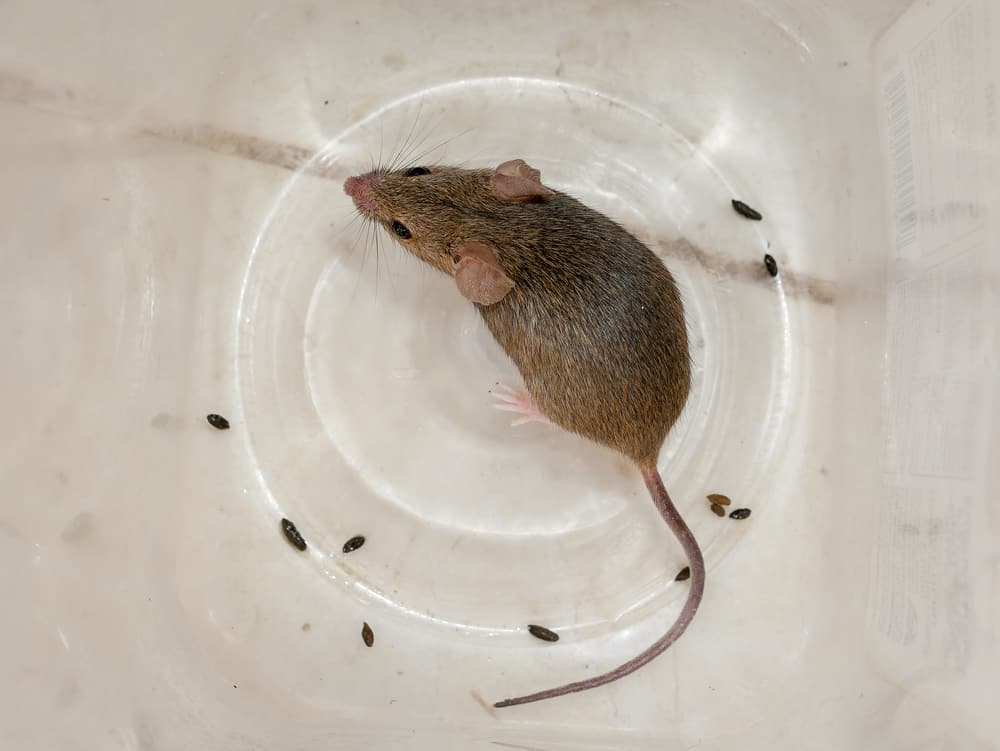posts and pages could include affiliate links which may result in earnings for the site. As an amazon associate, we earn from qualified purchases.
Finding animal droppings in your home is worrying. It suggests you have some kind pest on your property, which could cause damage or put you and your family at risk of getting ill.
It can be difficult to tell what kind of pest you are dealing with, but the droppings can help to identify the infestation.

Many people dislike rats and would dread finding rat droppings in their home. rats can be very destructive, they carry dangerous diseases and they breed quickly, which means a small infestation can soon become a big problem.
So how can you tell if the droppings you have found in your home belong to rats? If they are rat droppings, how do you clean it up safely?
Keep reading to find out more.
Shape & Distribution
Rats leave pellet shaped droppings, usually grouped together. To contain odors, rats tend to return to the same place to defecate, and it is often a place of safety or somewhere close by.
It could be in an attic or basement, or close to a well insulated piece of wall. The droppings will be in an area that the rat can fit – they are larger than other pests like mice and roaches, so their poop won’t be tucked away in cramped, difficult to reach places.
A single rat will drop between 30 to 55 droppings per day, so the amount of droppings can be useful to determine how many rats are inside your home.
Size
Rat droppings vary in size depending on the type of rat and the age of the rat that made the droppings.
If the droppings are smaller than a grain of rice, they are usually from a mouse, a bat or they could even be from a roach.
If they are bigger than a grain of rice, they were most likely from a rat or larger rodent. The average adult rat feces pellet is about the size of an olive.
Color & Texture
Fresh rat feces is black, moist and shiny. The blacker the poop, the fresher it is.
As the poop dries out it turns gray and becomes more crumbly. Knowing how fresh the feces can help you to determine whether the infestation is old or new.
Odor
They have a scavenger’s diet, and Rat droppings have a musky smell, but they are always accompanied by rat urine which is much more pungent.
Is Rat Poop Dangerous?
As well as causing damage to properties, rats are also able to spread disease. They were responsible for spreading the bubonic plague, killing over a third of the European population in the Middle Ages.
Rat poop harbours a lot of dangerous bacteria which can contaminate food, cause allergic reactions or spread dangerous diseases. Even old, dried out rat droppings are dangerous.
Salmonellosis is a type of food poisoning caused by consuming food that has been contaminated by with animal feces, including rat droppings. It can cause symptoms like fever, chills, abdominal pain and diarrhea.
You also contract rat bite fever from eating contaminated food. This is a dangerous condition that causes vomiting, muscle pain, headaches, a fever and a rash.
Hantavirus is a disease spread by rat poop that can be lethal to humans. You can catch the disease from being exposed to infected droppings, saliva or urine, so if you have a rat infestation in your house then you could be at risk.
The viral particles can suspend in the air, making home renovations a potential point of contamination.
Early symptoms of hantavirus include dizziness, fatigue, muscle aches, chills, a fever, headaches and abdominal pain.
Rat droppings can also cause diseases in other animals like dogs. If a dog comes into contact with rat droppings they could contract rat bite fever, roundworm, or diseases like leptospirosis and toxoplasmosis.

How To Clean Rat Poop Safely
Now that you know all the risks associated with rat poop, the idea of going near it to clean it up is probably quite daunting. But don’t worry, it is possible to clean up rat poop safely.
It is important to get rid of it as soon as possible to make your home safer while you wait for pest control to come and get rid of the infestation.
If possible and safe, take some photographs of the droppings before you clean them as this will help the pest control expert determine the size of the infestation.
If you are pregnant, do not clean the rat droppings yourself as you are at a much greater risk.
The first thing you need to do is ventilate the room with the rat droppings in it. Open the doors and windows and wait half an hour before going back into the room.
Before you start cleaning, you will need to put on some protective gear.
Wear rubber gloves to stop your hands from coming into contact with the droppings. You should also wear a face mask and protective goggles to stop you from being exposed to any contaminated dust particles.
You will need to prepare a disinfectant solution that is 10% chlorine bleach diluted in hot water. Do not sweep up the droppings or vacuum them.
Spray them with the disinfectant solution, then collect them with a paper towel. Place the paper towels inside a sealable plastic bag and dispose of the waste in an outdoor trash can.
Make sure no other animals will be able to get to the droppings as they will be very harmful.
Once the droppings have been removed, you will need to clean all surfaces in the room with the disinfectant solution, then dry the surfaces with paper towels.
Put the clothes you were wearing straight in the wash, preferable on a high heat setting. Wash your hands with disinfectant soap and have a shower straight away.
Make sure you carefully dispose of the contaminated protective gear in a sealed plastic bag also.
How To Get Rid Of A Rat Infestation
As soon as you see rat droppings in your home then you need to call a pest control company. Especially if you’re not willing to kill them yourself.
Rodents like rats breed very quickly, so a small infestation can quickly become a very large scale problem. The sooner it is dealt with the better. DIY rat infestation removal is not recommended.
